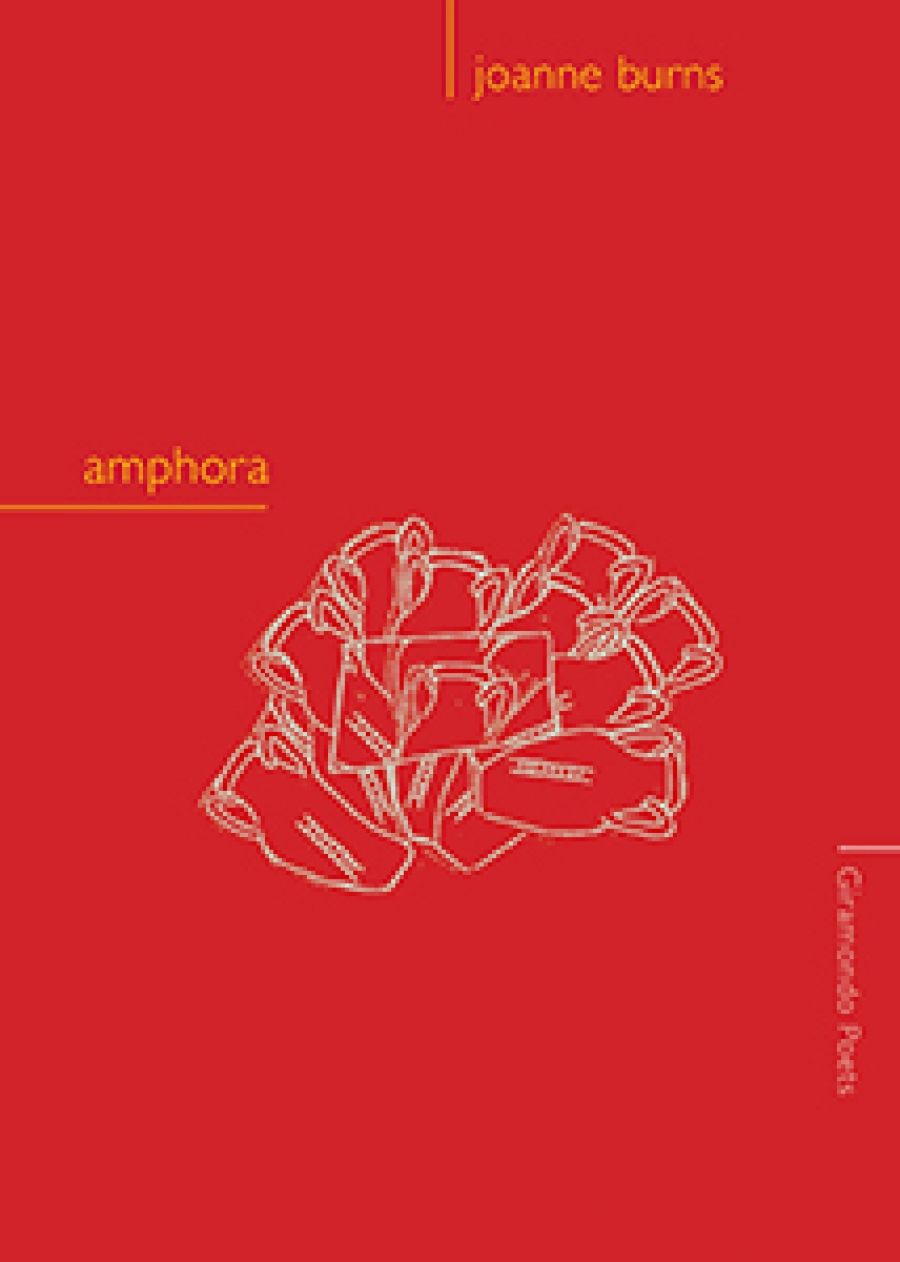
- Free Article: No
- Contents Category: Poetry
- Review Article: Yes
- Article Title: Scatter
- Online Only: No
- Custom Highlight Text:
joanne burns has long been a force in Australian poetry. amphora, her thirteenth collection, builds on that legacy with the energy and vital idiosyncrasy with which readers have come to associate her work. The collection’s title – one of the sections of poetry – gives us a clue as to what we will find here. burns offers her reader an amphora, and thereby casts her book as a beautiful jar brimming with words and insights, stories from the past, sustenance for the present. William Carlos Williams wrote, ‘… men die miserably every day / for lack of what is found [in poems].’ Drink deeply, amphora urges us, because poetry contains the very stuff of life.
- Book 1 Title: amphora
- Book 1 Biblio: Giramondo, $24.95 pb, 136 pp
The book’s first section, ‘ichoria’, or the fluid that flows in the veins of the gods, sets out burns’s interests here: myth, antiquity, as well as the diving for what is personally crucial and fundamental. This quasi-quest is undercut by burns’s characteristic irony and humour: ‘i know an angel poem can be a cliché / but every poet’s got an angel somewhere / cruising through their work even if they don’t / admit it.’ In addition, as her subtitle ‘angles not angels’ suggests, this is no sentimental revival of the traditional figure or genre, but rather burns’s poetry functions at sharp, sometimes discordant angles to our expectations: ‘enough of biblical / endurance and ordealism. i climb down the ladder / of memory … arms lifting over the water like sudden wings. kicking / towards epiphany. so this is heaven,’ she writes in ‘rung’. Old stories or religious convention might offer a rung or two on a ladder to somewhere else, to seeing the world with freshness and vigour, but it is the leap of the poem, its willingness to risk the unexpected, that enables it – and the reader – to find their way to a kind of catharsis.
The personal ladder of memory is also traversed in the section ‘soft hoods of saints’, where burns revisits and re-imagines the saints of her Catholic girlhood. Here she teases out the violence of martyrdom, the implicit sexualisation of the virginal girl, the poet’s transformation of the boy saint into her own inspiring image of ‘emily dickinson also clothed in white walking down / the road below the plate, from her nature’s dining room’. Or the poem ‘haggle’, where a hagiography of saints is revisioned through a linguistic inventory of names, a plethora of ‘god’s good / bureaucrats … the showbiz / circus sideshow, the special effects saints / … why not imagine them as spiritual pets’, the speaker wryly asks, with the perspective of poet rather than of child or initiate.
In the section ‘streamers’, burns riffs on the Zen concept of the koan, a problem or a riddle with no clear or logical outcome, to devise her own series of joanne-inspired ‘koannes’. Take, for example: ‘weigh the rice before you boil it / how else can you catch up / with yourself …’; or ‘a choice of empty restaurants / a shudder of tree fern harvests / in your bitter hair’. Such vignettes, or fragments of poems, provide an almost imagistic, haiku-esque set of visions. The pictures and ideas work at those odd angles to one another, neither resolving or coalescing, but instead creating a state of questioning, a ‘missing trail of breadcrumbs’, suggesting the idea of a hunt for meaning which has left no clues, and which has evaporated back into the many versions of the story. As she writes in the poem ‘lathe’, ‘may / the polysemic flower’: in other words, her poetry exhorts us to follow the many trails of language, its different and contradictory paths.
Just as there is a plethora of ideas in burns’s work, so too is there an abundance of poetic styles. As well as writing what might be recognised as a lyric, burns also explores the prose poem, the imagistic vignette, the inventory, the Williams-esque open and split lines. Most noticeable, too, is the distinctive use of punctuation. A little like Dickinson herself, or e.e. cummings, burns eschews conventional capitalisation and punctuation, working to keep a reader guessing as to the poem’s unravelling of meaning, as well as suggesting a flatter, more democratic approach to language and its systems. The poet’s words all exist on a plane together, non-hierarchical, ready to be shaped by the process of reading as much as by the process of writing.
burns’s work presents an often obscure wealth of ideas and language, which can keep the reader on the hop, chasing ideas that are sometimes deliberately cryptic, often not laid out in any self-evident way. As the poet writes in ‘zag’, ‘the poems are running / running away running from / the dread of having to explain themselves … / at least they can live in privacy if / they scatter’. This poetic method can leave a reader frustrated or intrigued, depending on whether she is willing to follow the poems into whatever hidey holes they might be ‘running’ into.
‘always dicy, this word play. You let the words roll / around in your mouth till their sheer brio pushes / them out through your cheeks,’ says the poem ‘stock’ as burns chews and tosses her ingredients into the gamble of the poem. We may not always know where these poems are leading, or even what concoctions we could help to cook up – but the process is rewarding.


Comments powered by CComment